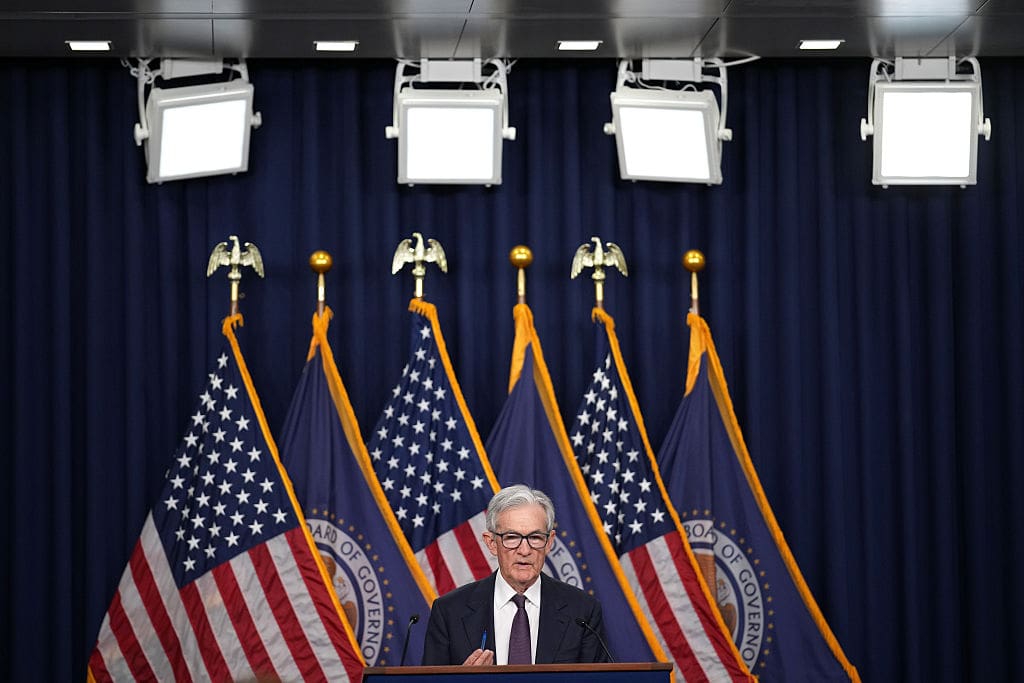



Loading the Elevenlabs Text to Speech AudioNative Player...
President Donald Trump has ratcheted up his pressure campaign against Federal Reserve Chair Jerome Powell. In a series of public statements and Truth Social posts, Trump renewed his blistering attacks against the US central bank chief, calling him “a major loser” and stating that his “termination cannot come soon enough.” Inside his long list of criticisms, Trump may have made a point that Powell accidentally admitted was true.
The interest rate-setting Federal Open Market Committee (FOMC) finished its May policy meeting. The Eccles Building left the benchmark federal funds rate, a tool to influence economic activity, unchanged for the third consecutive meeting at 4.25% and 4.5%. Despite the first-quarter contraction and ubiquitous economic consternation, the Fed and Powell espoused the US economy’s vigorous health, alluding to the labor market, private investment, and consumer spending.
Answering a Bloomberg News reporter’s question about a soft-landing scenario, Powell averred that there is still immense uncertainty about the size, scope, timing, and length of the administration’s tariff agenda. Therefore, it would be challenging to make any bold predictions about the economy, inflation, unemployment, and monetary policy.
“In terms of preemption, I think you can look back at the 2019 cuts as preemptive. I wouldn’t say that what we did last fall was at all preemptive. If anything, it was a little late,” Powell said.
Six years ago, under pressure from Trump in his first term, the US central bank implemented three quarter-point interest rate cuts amid slowing international trade flows.
Liberty Nation depends on the support of our readers. Donate now!
In addition, during a separate exchange, Powell agreed that the Fed could have tapered the pandemic-era stimulus actions “earlier or faster.” He has regularly accepted this position.
The president may want to pounce on these remarks if the White House paid attention to the press conference.
In April, the president took to social media to offer some fighting words to one of the world’s most powerful men. “There can be a slowing of the economy unless Mr. Too Late, a major loser, lowers interest rates, now,” he wrote on Truth Social. He commented similarly on the platform that he is “always too late and wrong.” Trump also told reporters that Powell is “always too late” and “a little slow.”
As Liberty Nation News has noted, monetary policy operates with a lag. Legendary economist Milton Friedman put forward this theory in the 1960s and 1970s, which has become the chief thinking for Powell and the rest of the Federal Reserve. A chorus of monetary policymakers, including Fed Gov. Christopher Waller, has started pushing back against this concept because of the Fed’s routine guidance and the forward-looking nature of the financial markets.
 Late last year, before the Fed embarked upon rate cuts, Jerome Powell explained that the entity would likely begin easing monetary policy before the annual headline inflation rate reached the central bank’s 2% target. If the Fed twiddled its thumbs until it reached that level, officials may have waited too long. Now that inflation has stabilized and is inching closer to the 2% objective, why not pull the trigger on rate cuts before a potential adverse scenario spirals out of control?
Late last year, before the Fed embarked upon rate cuts, Jerome Powell explained that the entity would likely begin easing monetary policy before the annual headline inflation rate reached the central bank’s 2% target. If the Fed twiddled its thumbs until it reached that level, officials may have waited too long. Now that inflation has stabilized and is inching closer to the 2% objective, why not pull the trigger on rate cuts before a potential adverse scenario spirals out of control?
The primary excuse has been tariff-related uncertainty throughout the global economy. But did the 2018-2019 on-again, off-again tariff whiplash also not produce uncertainty? When economic conditions normalized and inflation became a nightmare, why did the Fed wait until the spring of 2022 to take action?
Once again, it could be a case of the Federal Reserve shifting the goalposts. The Fed desired to engage in the rate-cutting cycle once super core ex-housing inflation stabilized. Then, it was the core personal consumption expenditure (PCE) price index. Before Powell headed the system, policymakers eyed wages as their guide for policy decisions.
Here is a question: If inflation fell 0.1% in March, the economy remains robust, and the job market is intact, why cut interest rates at all? Nobody knows the line of thinking other than that tariffs are the new excuse for the Federal Reserve.
President Trump and Treasury Secretary Scott Bessent have stated that Jerome Powell will finish his term when it expires in May 2026. The search for his successor will start in the fall, and everyone knows it will be former Fed Gov. Kevin Warsh. If the administration sought to fire Powell, would it be justified? Indeed, Powell has navigated one crisis after another over the last several years, from the coronavirus pandemic to a 40-year high inflation rate to bank failures. Still, the Federal Reserve has established an abysmal track record – some actions have contributed to other developments – and the blame will always rest at the top.
